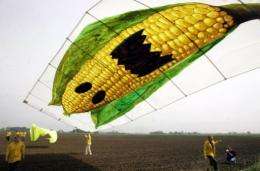GMO corn falls prey to bugs it was supposed to thwart

A voracious pest which has long plagued corn farmers is devouring a widely-used variety that was genetically modified to thwart the rootworms, raising fears of a new superbug.
So far, there is no evidence that a significant number of rootworms have developed a resistance to the corn's protective toxin.
However, experts warn that farmers may be forced to resume the heavy use of pesticides if resistant bugs become widespread.
They also caution that farmers may be using genetically modified crops in ways that hasten the development of resistant bugs.
"The western corn rootworm is one of the most significant insect pests of corn in the United States and has a potential to become a very significant insect in Europe," said Michael Gray, a crop scientist at the University of Illinois.
Farmers used to be able to manage the pests by rotating which crops they planted in their fields.
But rootworms started to lay their eggs on soybeans -- the most common substitute -- which meant farmers had to use pesticides to get rid of them. The hardy and adaptive bugs have also developed resistance to some pesticides, Gray said Monday.
Monsanto released the first seeds that were genetically-modified to protect themselves from rootworms in 2003. US farmers used this type of seed for 45% of the US crop in 2009.
Evidence of the first resistant rootworms was found in four Iowa fields that suffered extensive damage from the pests in 2009.
Gray is currently investigating whether rootworms which devoured genetically modified corn in Illinois this year have also developed a resistance.
Laboratory testing published last month confirmed that the bugs collected from the Iowa fields were able to pass a resistance to the crop's toxins on to their offspring.
"These results suggest that improvements in resistance management and a more integrated approach to the use of Bt crops may be necessary," wrote lead researcher Aaron Gassmann of Iowa State University.
The fields where the resistant rootworms were found had been planted with the genetically modified seeds for at least three consecutive years.
That could have helped the bugs develop a resistance, Gassmann wrote.
Another contributor could be the insufficient use of "refuges," he concluded.
Farmers are supposed to plant 20 percent of their fields with corn that doesn't have the genetic modification so that if resistant bugs develop they will end up breeding with non-resistant rootworms drawn to the unprotected plants and lessen the chance of passing resistance on to the next generation.
Monsanto is already working to make it easier for farmers to comply with these government-mandated "refuges" by selling bags that contain a mix of unprotected and protected seeds.
It also has several other products already on the market which could work as a substitute if significant resistance develops and has several new products in the pipeline, said spokesman Lee Quarles.
But while Monsanto is taking the study results "seriously" there is no reason for farmers to stop using the current seeds, he said.
"Today's products work," Quarles told AFP. "They continue to provide tremendous performance to farmers and we're seeing that performance on greater than 99% of all acres planted."
(c) 2011 AFP















